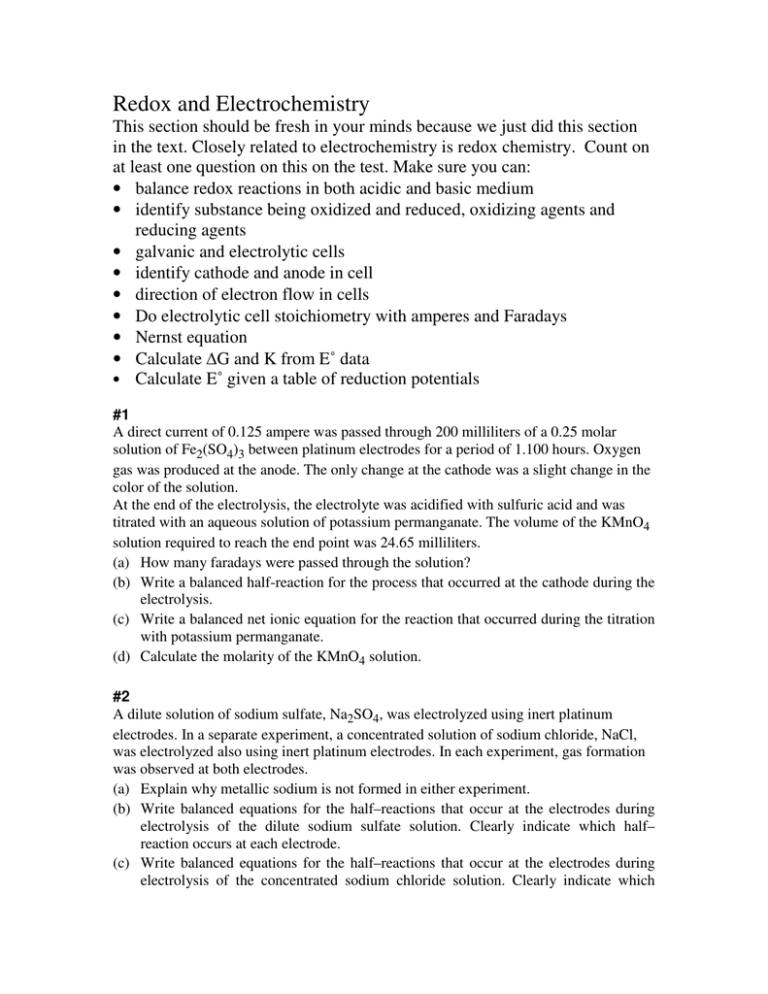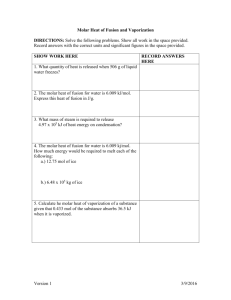Redox and Electrochemistry
advertisement

Redox and Electrochemistry This section should be fresh in your minds because we just did this section in the text. Closely related to electrochemistry is redox chemistry. Count on at least one question on this on the test. Make sure you can: • balance redox reactions in both acidic and basic medium • identify substance being oxidized and reduced, oxidizing agents and reducing agents • galvanic and electrolytic cells • identify cathode and anode in cell • direction of electron flow in cells • Do electrolytic cell stoichiometry with amperes and Faradays • Nernst equation • Calculate ∆G and K from E˚ data • Calculate E˚ given a table of reduction potentials #1 A direct current of 0.125 ampere was passed through 200 milliliters of a 0.25 molar solution of Fe2(SO4)3 between platinum electrodes for a period of 1.100 hours. Oxygen gas was produced at the anode. The only change at the cathode was a slight change in the color of the solution. At the end of the electrolysis, the electrolyte was acidified with sulfuric acid and was titrated with an aqueous solution of potassium permanganate. The volume of the KMnO4 solution required to reach the end point was 24.65 milliliters. (a) How many faradays were passed through the solution? (b) Write a balanced half-reaction for the process that occurred at the cathode during the electrolysis. (c) Write a balanced net ionic equation for the reaction that occurred during the titration with potassium permanganate. (d) Calculate the molarity of the KMnO4 solution. #2 A dilute solution of sodium sulfate, Na2SO4, was electrolyzed using inert platinum electrodes. In a separate experiment, a concentrated solution of sodium chloride, NaCl, was electrolyzed also using inert platinum electrodes. In each experiment, gas formation was observed at both electrodes. (a) Explain why metallic sodium is not formed in either experiment. (b) Write balanced equations for the half–reactions that occur at the electrodes during electrolysis of the dilute sodium sulfate solution. Clearly indicate which half– reaction occurs at each electrode. (c) Write balanced equations for the half–reactions that occur at the electrodes during electrolysis of the concentrated sodium chloride solution. Clearly indicate which half–reaction occurs at each electrode. (d) Select two of the gases obtained in these experiments, and for each gas, indicate one experimental procedure that can be used to identify it. #3 An electrochemical cell consists of a tin electrode in an acidic solution of 1.00 molar Sn2+ connected by a salt bridge to a second compartment with a silver electrode in an acidic solution of 1.00 molar Ag+. (a) Write the equation for the half–cell reaction occurring at each electrode. Indicate which half–reaction occurs at the anode. (b) Write the balanced chemical equation for the overall spontaneous cell reaction that occurs when the circuit is complete. Calculate the standard voltage, E˚, for this cell reaction. (c) Calculate the equilibrium constant for this cell reaction at 298K. (d) A cell similar to the one described above is constructed with solutions that have initial concentrations of 1.00 molar Sn2+ and 0.0200 molar Ag+. Calculate the initial voltage, E˚, of this cell. #4 The electrolysis of an aqueous solution of potassium iodide, KI, results in the formation of hydrogen gas at the cathode and iodine at the anode. A sample of 80.0 milliliters of a 0.150 molar solution of KI was electrolyzed for 3.00 minutes, using a constant current. At the end of this time, the I2 produced was titrated against a 0.225 molar solution of sodium thiosulfate, which reacts with iodine according to the equation below. The end point of the titration was reached when 37.3 milliliters of the Na2S2O3 solution had been added. I2 + 2 S2O32- → 2 I- + S4O62(a) How many moles of I2 was produced during the electrolysis? (b) The hydrogen gas produced at the cathode during the electrolysis was collected over water at 25˚C at a total pressure of 752 millimeters of mercury. Determine the volume of hydrogen collected. (The vapor pressure of water at 25˚C is 24 millimeters of mercury.) (c) Write the equation for the half–reaction that occurs at the anode during the electrolysis. (d) Calculate the current used during the electrolysis. #5 Explain each of the following. (a) When an aqueous solution of NaCl is electrolyzed, Cl2(g) is produced at the anode, but no Na(s) is produced at the cathode. (b) The mass of Fe(s) produced when 1 faraday is used to reduce a solution of FeSO4 is 1.5 times the mass of Fe(s) produced when 1 faraday is used to reduce a solution of FeCl3. (c) Zn + Pb2+ (1–molar) → Zn2+ (1–molar) + Pb The cell that utilizes the reaction above has a higher potential when [Zn2+] is decreased and [Pb2+] is held constant, but a lower potential when [Pb2+] is decreased and [Zn2+] is held constant. (d) The cell that utilizes the reaction given in (c) has the same cell potential as another cell in which [Zn2+] and [Pb2+] are each 0.1–molar. #6 An unknown metal M forms a soluble compound, M(NO3)2. (a) A solution of M(NO3)2 is electrolyzed. When a constant current of 2.50 amperes is applied for 35.0 minutes, 3.06 grams of the metal M is deposited. Calculate the molar mass of M and identify the metal. (b) The metal identified in (a) is used with zinc to construct a galvanic cell, as shown below. Write the net ionic equation for the cell reaction and calculate the cell potential, E˚. K Metal M + Cl - Zinc 1.0 M M(NO3)2 1.0 M ZnSO4 (c) Calculate the value of the standard free energy change, ∆G˚, at 25˚C for the reaction in (b). (d) Calculate the potential, E, for the cell shown in (b) if the initial concentration of ZnSO4 is 0.10-molar, but the concentration of the M(NO3)2 solution remains unchanged. #7 A galvanic cell is constructed using a chromium electrode in a 1.00-molar solution of Cr(NO3)3 and a copper electrode in a 1.00-molar solution of Cu(NO3)2. Both solutions are at 25˚C. (a) Write a balanced net ionic equation for the spontaneous reaction that occurs as the cell operates. Identify the oxidizing agent and the reducing agent. (b) A partial diagram of the cell is shown below. Cr Cu 1.0 M Cu(NO 3)3 1.0 M Cr(NO 3)3 (i) Which metal is the cathode? (ii) What additional component is necessary to make the cell operate? (iii) What function does the component in (ii) serve? (c) How does the potential of this cell change if the concentration of Cr(NO3)3 is changed to 3.00-molar at 25˚C? Explain. REDOX & ELECTROCHEMISTRY ANSWERS #1 Answer: (a) (1.100 hr)(3600 sec hr ) = 3960 sec. (3960 sec)(0.125 amp) = 495 coul 1 farad 495 coul × = 5.13×10-3 faraday 96500 coul (b) Fe3+ + 1e- → Fe2+ (c) MnO4- + 8 H+ + 5e- → Mn2+ + 4 H2O 5 Fe2+ → 5 Fe3+ + 5e- ________________________________________________ MnO4- + 8 H+ + 5 Fe2+ → 5 Fe3+ + Mn2+ + 4 H2O (d) 5.13×10 −3 1 mol Fe2+ 1 mol MnO-4 farad × × 1 farad 5 mol Fe2+ × 1 = 0.0416M MnO −4 0.02465L #2 Answer: (a) Na+ is not reduced as easily as H2O (or H+ or OH–). OR If Na(s) were formed, it would rapidly react with water to reform Na+. (b) Anode: 2 H2O → O2 + 4 H+ + 4ecathode: 2 H2O + 2e- → H2 + 2 OHor: 2 H+ + 2e- → H2 (c) anode: 2 Cl- → Cl2 + 2ecathode: 2 H2O + 2e- → H2 + 2 OHor: 2 H+ + 2e- → H2 (d) H2 - “pop” with a lit splint; O2 - ignites a glowing splint; Cl2 - yellowish-green color (other suitable tests accepted) #3 Answer: (a) Sn → Sn2+ + 2e- anode reaction Ag+ + e- → Ag (b) 2 Ag+ + Sn → 2 Ag + Sn2+ E˚ = [0.80v - (-0.14v)] = 0.94v 0.0592 log K OR − nFE = −RT ln K (c) E = n 0.94 × 2 log K = = 31.8 ; K = 6×10 31 0.0592 RT [Sn 2+ ] (d) E = EÞ− ln Q ; Q = nF [Ag + ]2 0.0592 1 log E = 0.94 − 2 = 0.84v 2 (0.02) #4 Answer: 0.225molS2O2− 1 mol I2 3 (a) 0.0373L × × = 1L 2 mol S2O2− 3 4.20×10-3 mol I2 (b) PH2 = Ptotal - PH2O = (752 - 24) mm Hg = 728 mm Hg 1 mol H2 = 1 mol I2 PV = nRT ; V = nRT/P V= ( ) L⋅atm (4.20×10− 3 mol) 0.0821 mol⋅K (298K) ( 728 760 )atm = = 0.107 L (c) At anode: 2 I- → I2 + 2e(d) 4.20×10 −3 2 mol e− 96489amp ⋅ sec mol I2 × × × − 1 mol I2 1 mol e × 1min 1 × = 4.50 amp 60sec. 3min. #5 Answer: (a) Cl– is more easily oxidized than water water is more easily reduced than Na+ farad (b) Fe2+ req. 2 mol Fe(s) or 1 farad → 1/2 mol Fe(s) farad Fe3+ req. 3 mol Fe(s) or 1 farad → 1/3 mol Fe(s) for equal numbers of farad 1/2:1/3 :: 1.5:1 (c) using LeChatelier’s principle if [Zn2+] ↓, reaction shifts →, ∴ cell potential ↑ if [Pb2+] ↓, reaction shifts ←, ∴ cell potential ↓ or using the Nernst Equation Ecell = E˚ - RT lnQ, where Q = [Zn2+]/[Pb2+], if [Zn2+] ↓, Q<1, Ecell > E˚ if [Pb2+] ↓, Q>1, Ecell < E˚ (d) [Zn2+]/[Pb2+] does not change regardless of the values, ∴ Ecell = E˚ or [Zn2+]/[Pb2+] = 1; ln Q = 0; Ecell = E˚ #6 Answer: 1 mol e− 60sec. 35.0min (a) 2.50amp × × × × 96500amp ⋅ sec 1min. 1 × 3.06 g / 2.72×10-2 mol = 112 g/mol; ∴ metal is Cd (b) Zn → Zn2+ + 2eE˚ = +0.76 v 2+ Cd + 2e- → Cd E˚ = -0.40 v _______________________________________ Cd2+ + Zn → Cd + Zn2+ E˚ = +0.36 v (c) ∆G˚ = -nFE˚ = -(2)(96.5 kJ/v)(0.36v) = -69 kJ 0.0592 [Zn 2+ ] (d) E cell = EÞ− log 2+ n [Cd ] E cell = 0.36v − 0.0592 0.10 log = 0.39v 2 1 #7 Answer: (a) 2 Cr + 3 Cu2+ → 2 Cr3+ + 3 Cu Cr = reducing agent; Cu2+ = oxidizing agent (b) (i) Cu is cathode (ii) salt bridge (iii) transfer of ions or charge but not electrons (c) Ecell decreases. use the Nernst equation to explain answer 1 mol M − = 2.72×10 2 mol e −2 mol





